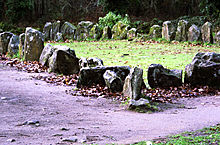|
|
|
|
Quadrilataire de ManioTertre Tumulaire
|
||||||||||||||||||
|
|
|
Images (click to view fullsize) |
|












|
Fieldnotes |
|
|
Visited 18.09.23 The Quadrilataire de Manio is one of Carnac's more enigmatic monuments. It is difficult to imagine how this stone rectangle would have fitted into the Carnac Complex. The proximity of the Geant du Manio merely adds to the air of mystery. |
Posted by markj99 8th October 2023ce |
|
Visited 29th October 2013 Slap bang next to the giant is another of Brittany’s enigmatic stone settings, the Quadrilateral de Manio. Basically a large stone rectangle, with a porch type setting at one end, which would once have provided a forecourt facing to the south-east. It’s amazing to think that apparently this would have once been covered by a huge mound. Trees surround the site preventing an observation of the wider area, and I wonder whether the menhir was erected first, or if it was intended as some sort of indicator stone for the Quadrilateral? Burl says the stones were set on a long low mound, but it’s difficult to make this out now. It’s just about possible to get a photo of the whole of the site in shot , as long as you take your picture from the forecourted end, otherwise some manoeuvring about the trees is required if you want to take a photo from the west end. I resort to clambering onto the low stone wall which surrounds the site in order to get a slightly elevated view, and manage to get a few photo’s between the regular procession of visitors. The woodland setting with its dappled light, nearby onlooking menhir, and just proximity to the megalithic wonderland that is Carnac make it a special place, and although a popular site in its own right, it retains a peaceful air, somewhere to ponder on the amazing ancient remains surrounding you, away from the hustle and bustle of the tourists at the main visitors center. |
15th November 2013ce |
| I'd never seen a stone rectangle before! It has shortish stones which create a wall effect as they are quite close together. It tapers slightly to one end and there's a theory that perhaps it once enclosed a mound, but it somehow didn't feel right for that. It felt more like a meeting place to me. |
 Posted by Jane
Posted by Jane2nd August 2007ce |
|
After a fairly long walk through the woods past some freindly horses in a field, we come to a stone rectangle, after seeing so many stone circles back home this rectangle was a real oddity that I just had to inspect in fine detail. The stones are fairly low 1 to 2 feet at most, except two on one of the long sides which look like an entrance, if a little constricted .Apparently restored quite recently. Only yards away is the Giant of Manio, a real whopper |
 Posted by postman
Posted by postman1st August 2007ce |
Links |
|
Howard Crowhurst and the Manio Conception Triangle | Ancient Mathematics | N J WildbergerIn this video and the following we introduce Howard Crowhurst's significant discoveries of two remarkable 3-4-5 triangles---the Life triangles--- at an area famous for the Manio Giant menhir at Carnac in Brittany. These are probably the first 3-4-5 triangles known in history, and Howard has discovered that these configurations bring together ancient astronomical alignments, geometry and the biology of conception and fertility. Howard's remarkable analysis of this site deserves wider recognition and study. I am grateful to him for giving me a personal tour of the area and his fascinating explanation of it. It opens up a lot of questions about Neolithic thinking! |
15th November 2021ce Edited 15th November 2021ce |
Howard Crowhurst and the Manio Fertility Triangle | Ancient Mathematics | N J WildbergerThis video continues to describe Howard Crowhurst's remarkable discoveries in the Manio area of Carnac in Brittany of Neolithic geometry. Here he shows us a second 3-4-5 triangle adjacent to the Conception Triangle; this one is the Fertility Triangle and it is marked by another square stone at the perpendicular corner of this triangle. The exact dimensions of this triangle are 30,40 and 50 megalithic yards, using the fundamental unit established by Prof Alexander Thom after his study of 600 megalithic sites across England, Scotland, Wales and France. The hypotenuse of this Fertility Triangle is then the East-West line marked also by the Autumn Equinox, which is 9 months after the Winter Solstice when the shadow of the Manio Giant penetrates the two Portal stones. Do we have here Neolithic Family Planning? What other secrets could this site be holding? As Howard comments, this area really deserves some serious attention from archeologists! It raises a lot of questions about our understanding of the level of mathematics and astronomy of Neolithic people. |
15th November 2021ce Edited 15th November 2021ce |

